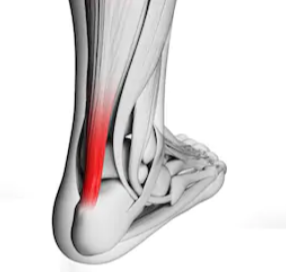Is it more likely a sign of a motor neuron disease if when your calf muscle twitches, your foot involuntarily moves with it?
The symptoms for ALS include the generic term of muscle twitching.
“Muscle twitching” is not a medical term, and hence, can mean different things when physicians hear this from patients.
The back of the lower leg is a common area for harmless muscle twitches: “a fasciculation — a small involuntary muscle contraction that is visible under the skin,” says Dr. David Beatty, MD, a retired general practitioner with 30+ years of experience and an instructor of general medicine for 20 years.
What if your foot moves with each twitch of the calf muscle?
This can set off the alarm bells for those suffering from health anxiety or who do not have knowledge of how neurons innervate in the lower leg.
The first thing to keep in mind is that the main calf muscle, the gastrocnemius, is actually a pretty big muscle.
This is why, when some people use a leg press machine at the gym and have too much weight loaded on it, they cheat by using their calves to help push the weight.
The calves are strong; they’re able to assist with the leg press machine when the user presses with the balls of their feet.
It stands to reason, then, that if there’s some twitching going on in the calf, it just might cause the foot to move.
“When the calf muscle twitches, the muscle fibers contracts (shorten),” says Dr. Beatty.
“As the calf contracts, this pulls the Achilles tendon upwards.
“The Achilles is attached to the back of the heel bone (the calcaneus).

Achilles tendon. Shutterstock/Sebastian Kaulitzki
“This acts as a pivot, causing the foot to move downwards (plantarflexion).
“You can demonstrate this by doing the Simmonds test. This is a test to check for a ruptured Achilles.
“The patient either kneels on a chair or lies face down on an examination couch with the feet hanging over the end of the couch.
“The doctor squeezes the calf, and the foot should move downwards. With a complete Achilles tendon rupture the foot doesn’t move.”
You can self-perform this test by sitting regular in a chair. Move one leg so that your thigh is over the front corner of the chair.
Extend your knee and lift your foot off the floor several inches.
With your hand, grasp the middle-lower portion of your calf and quickly squeeze and release.
You will observe a very slight downward movement of your foot.
If you don’t see it, you’re either squeezing too slowly, not hard enough or too high up on the leg.
If after making adjustments, you still don’t see your foot moving, do not panic and think you have a torn Achilles tendon.
First off, if you had a torn Achilles tendon, you’d have significant pain in that area when walking.
Second, a self-performed Simmonds test is awkward; it’s best performed by a second person.
The Simmonds test clearly demonstrates that it’s normal for the foot to move when the calf muscle is contracted – either by a hand squeezing it or by a benign fasciculation.
Can a twitching calf muscle mean any kind of neurological disease?
“If fasciculations in the calf are the only symptom, it isn’t likely to be due to anything serious,” says Dr. Beatty.
“I get them myself occasionally. I don’t think I’ve ever seen anyone present with just calf fasciculation which turned out to be anything major.
“Having said that, there are a whole range of neurological and general medical problems that can be associated with fasciculation.
“Almost always they will have more obvious worrisome symptoms [mainly weakness] that have preceded the fasciculations.
“Examples are motor neuron disease, multiple sclerosis, polio, nerve compression in cervical or lumbar spondylosis, and acquired myopathies such as those caused by thyrotoxicosis or polymyositis.”
Benign Causes of that Annoying Calf Twitch
“Less serious things that can be associated with fasciculations are stress, strenuous exercise, alcohol, caffeine, smoking, fatigue and viral infections,” says Dr. Beatty.
“Sometimes a nerve can be irritated by an awkward position or tense muscles.
“Benign fasciculations usually occur at rest and go away with exercise.
“Obviously, the more persistent or troublesome the symptom, the more it should be investigated.”
The video below shows how the Simmonds (or Thompson) test is performed.
 Dr. Beatty has worked in primary medicine, surgery, accident and emergency, OBGYN, pediatrics and chronic disease management. He is the Doctor of Medicine for Strong Home Gym.
Dr. Beatty has worked in primary medicine, surgery, accident and emergency, OBGYN, pediatrics and chronic disease management. He is the Doctor of Medicine for Strong Home Gym.
 Lorra Garrick has been covering medical, fitness and cybersecurity topics for many years, having written thousands of articles for print magazines and websites, including as a ghostwriter. She’s also a former ACE-certified personal trainer.
Lorra Garrick has been covering medical, fitness and cybersecurity topics for many years, having written thousands of articles for print magazines and websites, including as a ghostwriter. She’s also a former ACE-certified personal trainer.
.



























